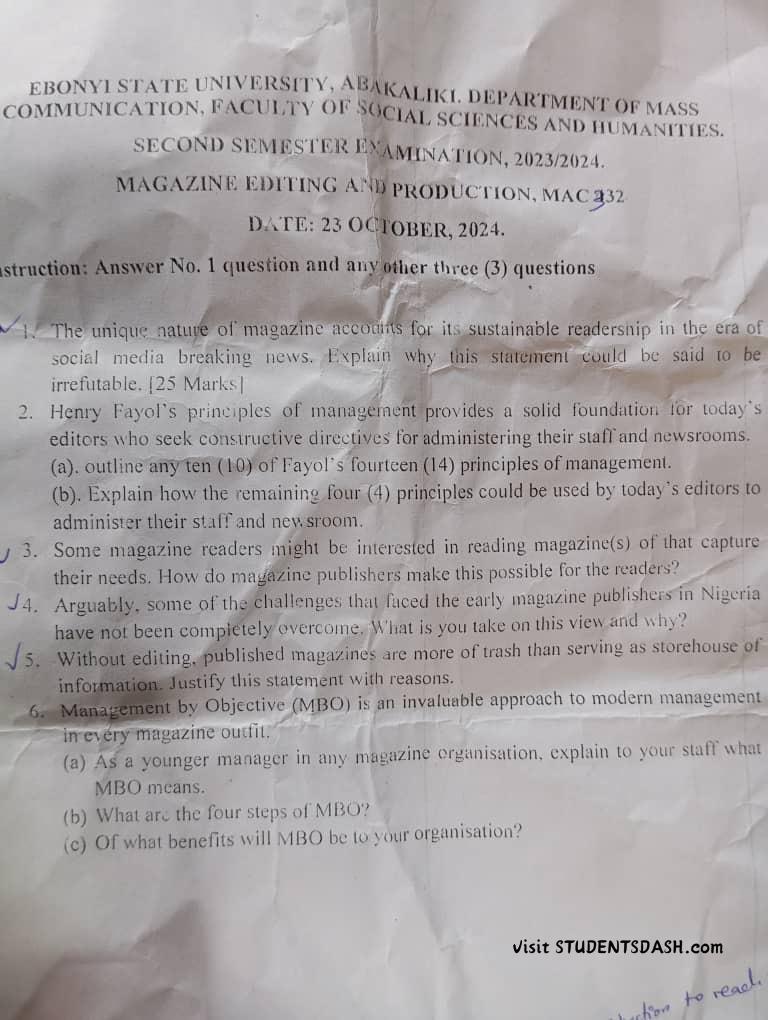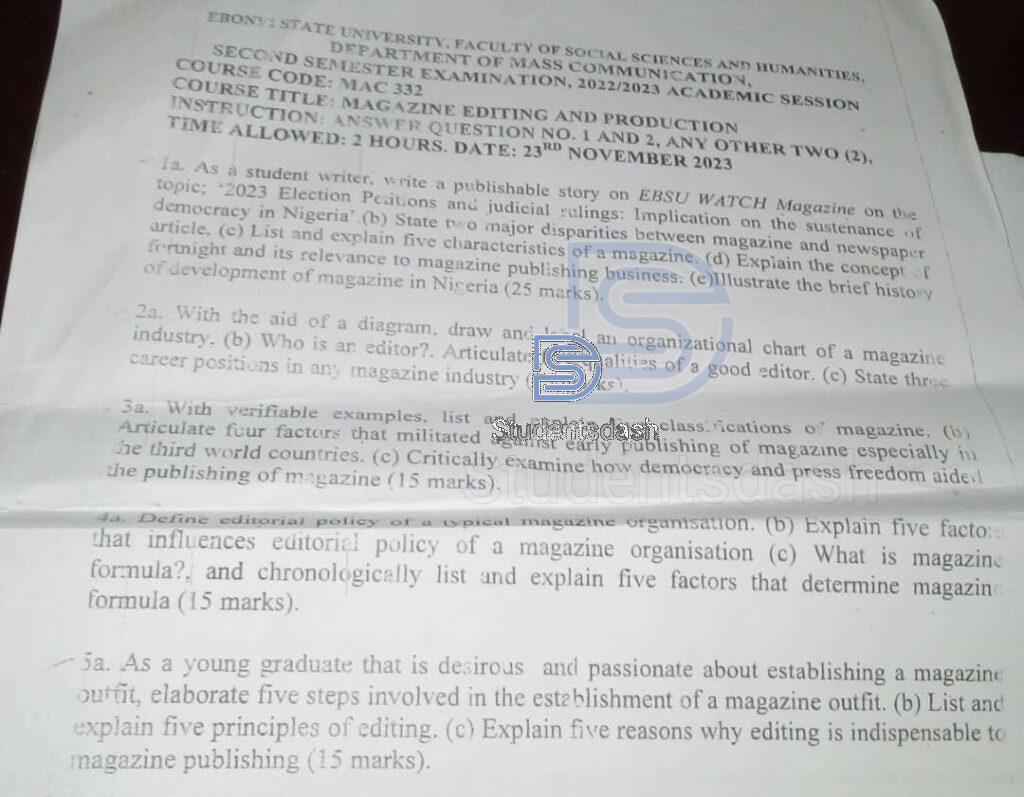

QUESTIONS AND ANSWERS
1a. As a student writer, write a publishable story on EBSU WATCH Magazine on the topic; “2023 Election Petitions and judicial rulings: Implication on the sustenance of democracy in Nigeria.”
Answer:
The 2023 election petitions and judicial rulings in Nigeria raised important debates about democracy. Many political parties challenged results in different states, claiming irregularities. The courts played a major role in deciding who truly won. These rulings gave citizens hope that democracy can be protected by law, but they also created tensions because some people believed the judgments favored certain parties. For democracy to be sustained, the judiciary must remain independent and fair. The outcome of these cases shows that democracy in Nigeria depends on strong institutions, respect for the rule of law, and citizens’ trust in the system.
1b. State two major disparities between magazine and newspaper article.
Answer:
- A newspaper article is usually brief and focused on immediate news, while a magazine article is longer and more detailed.
- Newspapers are published daily or weekly, while magazines are often published weekly, monthly, or quarterly with more in-depth analysis.
1c. List and explain five characteristics of a magazine.
Answer:
- Periodicity – Magazines are published at regular intervals, like weekly or monthly.
- Specialization – They often focus on specific topics such as fashion, sports, or politics.
- Attractive design – They use glossy paper, colorful images, and good layouts.
- Long shelf life – People keep magazines for a long time compared to newspapers.
- Feature-oriented – They contain detailed stories, features, and interviews rather than breaking news.
1d. Explain the concept of fortnight and its relevance to magazine publishing business.
Answer:
A fortnight means a period of two weeks. In magazine publishing, fortnightly editions give enough time to gather materials, design, and produce quality content. It balances timely reporting and detailed analysis, making it useful for business sustainability.
1e. Illustrate the brief history of development of magazine in Nigeria.
Answer:
Magazine publishing in Nigeria started in the colonial era. Early magazines like The Eagle and Nigeria Magazine appeared in the 1930s and 1940s. After independence, magazines such as Drum and Newswatch became popular, addressing politics, culture, and entertainment. Today, magazines like The News, Tell, and lifestyle publications continue the tradition, showing growth from colonial control to independent and diverse publishing.
2a. With the aid of a diagram, draw and label an organizational chart of a magazine industry.
Answer:
Diagram (text format):
- Publisher
- Editor-in-Chief
- Managing Editor
- Section Editors (Features, Sports, Business, etc.)
- Reporters/Writers
- Photographers
- Managing Editor
- Art Director
- Graphic Designers
- Advertising Manager
- Circulation/Marketing Manager
- Editor-in-Chief
2b. Who is an editor?
Answer:
An editor is a professional who plans, reviews, corrects, and manages content in a magazine to ensure quality, accuracy, and clarity before publication.
2c. Articulate five qualities of a good editor.
Answer:
- Good communication skills.
- Strong command of language.
- Ability to pay attention to detail.
- Fair judgment and decision-making.
- Creativity and vision.
2d. State three career positions in any magazine industry.
Answer:
- Feature Writer.
- Photojournalist.
- Circulation/Marketing Officer.
3a. With verifiable examples, list and explain five classifications of magazine.
Answer:
- News Magazines – e.g., Newswatch, focused on politics and current affairs.
- Lifestyle Magazines – e.g., Ovation, covering celebrities and events.
- Sports Magazines – e.g., Complete Sports, focusing on football and athletics.
- Fashion Magazines – e.g., ThisDay Style, covering trends and clothing.
- Educational Magazines – e.g., Students’ Digest, focusing on academics and youth.
3b. Articulate four factors that militated against early publishing of magazine especially in the third world countries.
Answer:
- Low literacy levels.
- High cost of printing and production.
- Poor distribution and infrastructure.
- Government censorship and restrictions.
3c. Critically examine how democracy and press freedom aided the publishing of magazine.
Answer:
Democracy creates an environment where different opinions are allowed. Press freedom gives publishers the right to report without fear. Together, they encourage investigative journalism, the growth of independent magazines, and public access to balanced information.
4a. Define editorial policy of a typical magazine organisation.
Answer:
Editorial policy is the guiding principle or set of rules that determines the type of content, tone, and style a magazine publishes to maintain consistency and reputation.
4b. Explain five factors that influence editorial policy of a magazine organisation.
Answer:
- Ownership interest.
- Target audience.
- Cultural values.
- Government regulations.
- Ethical standards.
4c. What is magazine formula?
Answer:
Magazine formula is the fixed structure or style a magazine follows, including layout, recurring sections, and type of content.
4d. Chronologically list and explain five factors that determine magazine formula.
Answer:
- Target audience – defines the focus and tone.
- Frequency of publication – daily, weekly, or monthly.
- Type of content – news, fashion, sports, etc.
- Design/layout style – pictures, columns, and graphics.
- Editorial policy – guiding rules for publishing.
5a. As a young graduate that is desirous and passionate about establishing a magazine outfit, elaborate five steps involved in the establishment of a magazine outfit.
Answer:
- Conduct market research.
- Develop a business plan.
- Secure funding.
- Recruit staff (editors, writers, designers).
- Register and launch the magazine.
5b. List and explain five principles of editing.
Answer:
- Accuracy – ensure facts are correct.
- Clarity – make writing simple to understand.
- Brevity – remove unnecessary words.
- Balance – present fair opinions.
- Consistency – follow style rules throughout.
5c. Explain five reasons why editing is indispensable to magazine publishing.
Answer:
- It removes errors and mistakes.
- It improves clarity and readability.
- It maintains the magazine’s standard.
- It ensures facts are accurate.
- It makes the publication professional and trustworthy.


